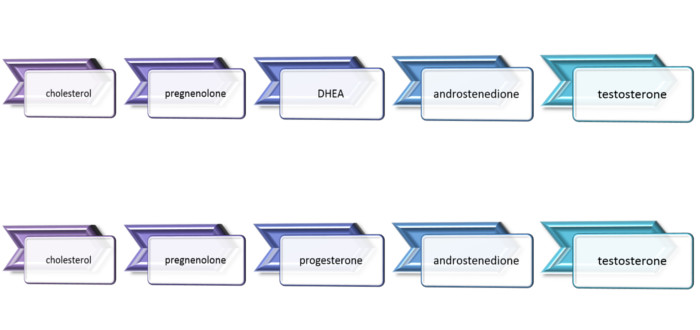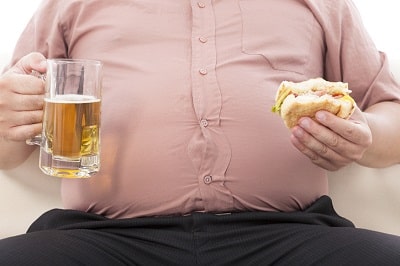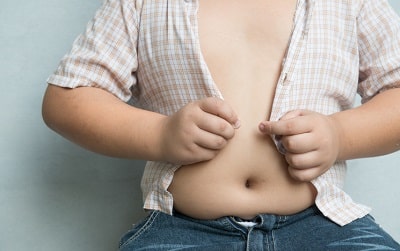
Can Testosterone Convert to Estrogen
Hormone production in the body requires many elements working together in harmony. Of the four different classifications of hormones – steroids, amino acids, peptides, and eicosanoids – it is steroid hormone production that stands out as all steroids hormones begin as cholesterol. Through a series of enzyme conversions that begins with cholesterol and ends with estradiol, we discover the answer to how can testosterone convert to estrogen.
For years, we have been told to avoid consuming cholesterol as it is bad for the heart. It turns out that the information we were given was false – based on a cover-up of research paid for by the sugar industry. We now know that it is sugar that is bad for the body, not healthy fats and egg yolks. Perhaps that is why so many adults are hormone deficient. Their bodies have not received the necessary basis for hormone production. Without adequate cholesterol, the following hormones may be deficient:
- Estrogen
- Testosterone
- Progesterone
- DHEA
- Pregnenolone
- Cortisol
- Androstenedione
That is just a few of the hormones that rely on cholesterol.
Before you can have testosterone conversion to estrogen, you must have testosterone. For the body to manufacture testosterone, it must first go through a multi-step process of converting cholesterol into a series of different hormones. The body uses a variety of enzymes to initiate that hormonal conversion. Also, other signaling hormones come from elsewhere in the endocrine system (typically peptide hormones) that stimulate the conversion process. For example, luteinizing hormone promotes testosterone production.
If you do not have all hormones and enzymes working together in unison, you will wind up with a hormonal imbalance. Because every adult body – male or female – requires balanced testosterone and estrogen levels, this process is essential.
Testosterone conversion into estrogen begins with cholesterol and requires a series of steps with other hormones and enzymes facilitating the conversion.
How Does the Body Convert Testosterone to Estrogen?
As we stated, the pathway of conversion begins with cholesterol. Its first synthesis is into the essential hormone pregnenolone, which then becomes either progesterone or 17a-OH-Pregnenolone. There are several pathways to get to testosterone, with the primary ones shown in the diagrams below. Further down the conversion chain is androstenedione, the direct precursor to testosterone. When asking how is testosterone converted to estrogen, this is the first step in the chain. Until you undergo the multistep process to get from cholesterol to testosterone, the body cannot produce estrogen.

Now that you have testosterone, how can testosterone convert to estrogen?
The body uses an enzyme called aromatase to facilitate the conversion of testosterone into the estrogen estradiol. Another estrogen, estrone, comes from aromatase conversion of androstenedione. Estrone conversion, in that case, bypasses testosterone in the process. There is also an enzyme that can convert estrone into estradiol. The majority of the estrogen in the body is estradiol coming from testosterone conversion. The process is the same for males and females; it is only the place of production (testes vs. ovaries) that differs.
How fast does testosterone convert to estrogen in the body?
There is no direct answer to that question. The mechanism and time of hormone production vary from person to person. Body composition plays a significant role in the conversion of testosterone to estrogen. People who are overweight have more aromatase as that enzyme is produced in fat – predominantly in belly fat. Although the fat under the skin throughout the body can manufacture aromatase, abdominal fat is the number one producer of the enzyme. That is also why people who are overweight have a higher risk for low testosterone. They produce so much aromatase that there is a higher degree of testosterone to estradiol conversion leaving them with very little free testosterone.
The body uses the enzyme aromatase – produced by belly fat – to facilitate testosterone conversion into estradiol – the primary form of estrogen.
Why Does Testosterone Convert to Estrogen?
 Asking why does testosterone convert to estrogen is like asking why we need food. Every hormone in the body has a purpose. Estrogen is crucial for brain functions, maintaining bone density, fertility, and sexual responses. Estradiol is a vital part of spermatogenesis in men. If a man is deficient in both testosterone and estrogen levels, he may experience infertility. Additionally, low testosterone and elevated estrogen levels can cause erectile dysfunction. Maintaining these hormones in proper balance is crucial.
Asking why does testosterone convert to estrogen is like asking why we need food. Every hormone in the body has a purpose. Estrogen is crucial for brain functions, maintaining bone density, fertility, and sexual responses. Estradiol is a vital part of spermatogenesis in men. If a man is deficient in both testosterone and estrogen levels, he may experience infertility. Additionally, low testosterone and elevated estrogen levels can cause erectile dysfunction. Maintaining these hormones in proper balance is crucial.
As we look at why testosterone converts to estrogen, the subject of osteoporosis stands out as a crucial reason. One function of estrogen in the body is to slow the process of bone turnover. Every human cell has a lifespan. When its time is up, it dies and requires another cell to take its place. With bone cells, a process called bone remodeling allows for the body to absorb the old bone cells and replace them with new ones. Estrogen ensures that the process of resorption does not happen faster than the production of new bone cells. Testosterone converting to estrogen helps to reduce the risk of developing osteoporosis if the bones weaken because absorption occurs faster than new bone growth.
Can testosterone convert to estrogen without aromatase activity?
No, both testosterone and androstenedione require aromatase for the conversion process. People who are extremely thin and have very little body fat may have reduced conversion. It is crucial to check both testosterone and estrogen levels if there are any symptoms of hormonal imbalance – especially in extremely thin or overweight individuals.
Testosterone conversion into estrogen is crucial as it helps maintain proper bone density, fertility, and sexual functions.
What Happens after Testosterone Converts to Estrogen?
After testosterone conversion to estrogen in males, the estradiol goes to work carrying out its functions. In addition to the testes, estrogen production can also occur in the brain, liver, fat, and muscle cells. Estrogen manufactured in these places often works locally, impacting functions in those areas. The biggest problem is when there is elevated estrogen production in fat. There, estrogen tells the body to increase fat storage, resulting in additional aromatase production. More aromatase means increased testosterone conversion.
The same problem happens with women. During menopause, this becomes especially concerning because the ovaries no longer produce progesterone, testosterone, and estrogen. However, the adrenal glands and brain still supply a small amount of progesterone and testosterone. Estrogen, however, comes from so many other places, including fat, that it tends to increase in comparison to the other two hormones. More about that in the next section.
Can testosterone convert to estrogen without it offsetting hormonal balance in the body?
Yes, that is how it is supposed to work. It is only when you add in mitigating factors such as body mass, environmental estrogens, food intake, lack of exercise, poor sleep, and other such issues that the balance is thrown off.
No matter who you are, your body needs a certain amount of estrogen for proper functions. Men require higher testosterone to estrogen ratios while the levels reverse for women who need more estrogen than testosterone in their bodies. Estrogen is also essential for maintaining healthy brain and cardiovascular functions.
Following testosterone conversion into estradiol, the hormone goes to work carrying out its estrogenic functions.
Are There Side Effects of Testosterone Converting to Estrogen?
There is always a reason why too much of a good thing can turn bad. Can testosterone convert to estrogen in too much of a quantity that it causes problems?
Yes, excessive estradiol conversion can lower the amount of free testosterone in the body. Only testosterone unbound to the protein sex hormone-binding globulin (SHBG) in the bloodstream can bind with androgen receptors to carry out testosterone functions. If too much aromatase in causing a decline in free testosterone, you wind up with a condition called “estrogen dominance.”
What happens when you have estrogen dominance?
The symptoms are essentially the same as with Low T. You may gain weight, become depressed, suffer from low libido, muscle loss, and thinning hair. Lack of energy is an issue, as is erectile dysfunction for men.
Can bioidentical testosterone convert to estrogen in the same way?
Yes, supplemental testosterone can also cause a problem if a person is predisposed to increased aromatase activity.
Is there a way to prevent testosterone conversion to estrogen?
Yes, the hormone specialist can prescribe an estrogen blocker to prevent aromatase conversion. The doctor will run comprehensive blood panels before beginning any hormone therapy. Measurements of testosterone and estrogen levels are included in these panels. Unless a person already has elevated estrogen levels, the doctor may wait and see how the body handles the increased testosterone before prescribing the aromatase blocker. It can always be added later if needed.
For more information about maintaining testosterone, estrogen, and hormonal balance, please contact our hormone clinic for a free consultation.
Too much estrogen is as bad as too little. An estrogen blocker can prevent testosterone conversion into estradiol to avoid side effects of Low T and elevated estrogen levels.

